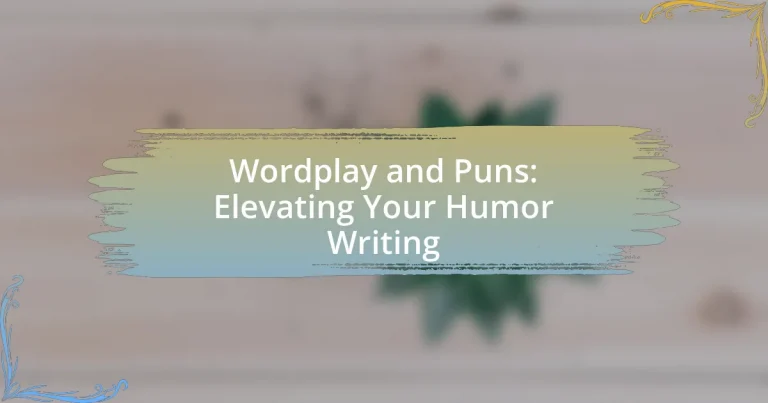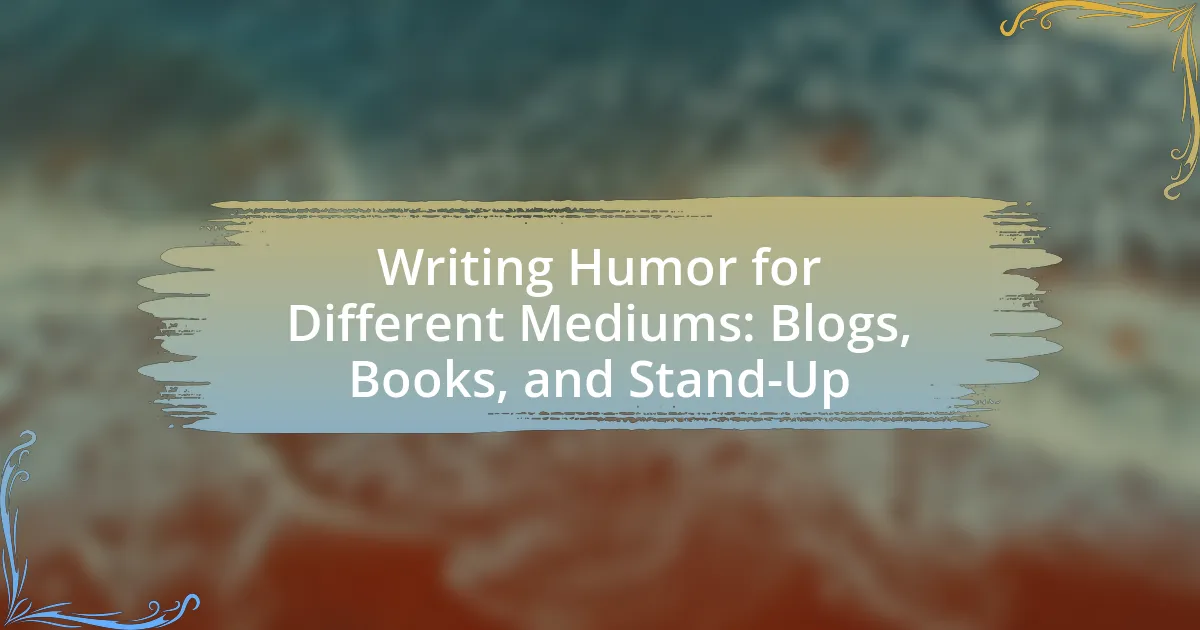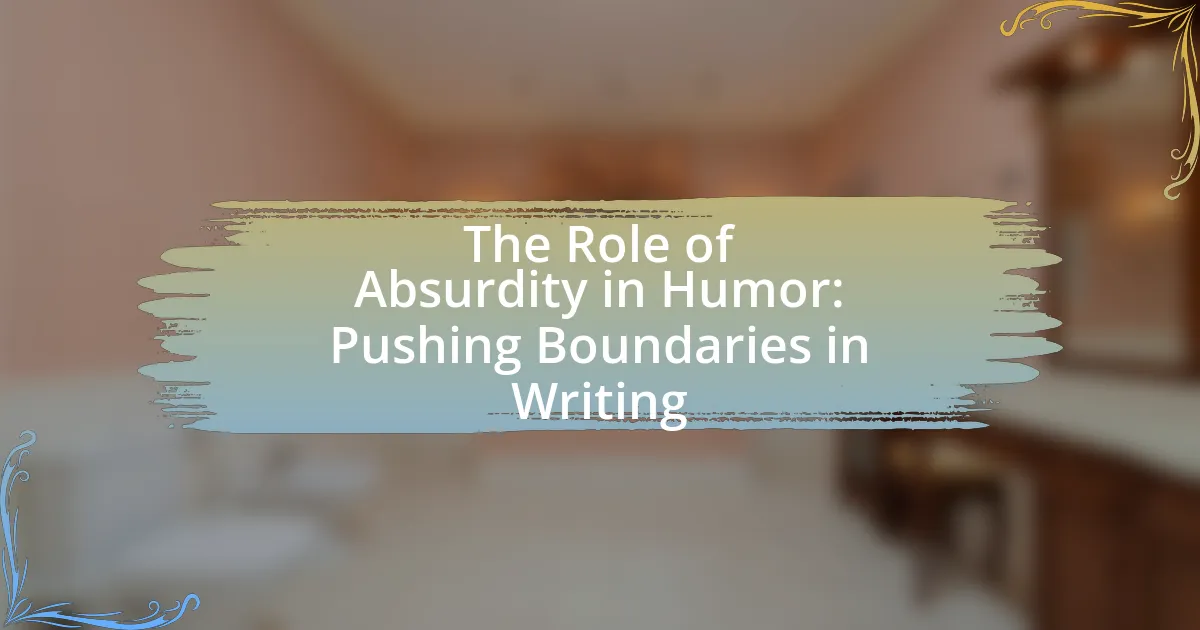Wordplay and puns are linguistic techniques that manipulate language to create humor, with puns specifically exploiting multiple meanings or similar-sounding words. This article explores how wordplay and puns enhance humor writing by fostering surprise and engagement, detailing various types such as malapropisms, spoonerisms, and double entendres. It also discusses the importance of these techniques in different writing contexts, their role in engaging audiences, and best practices for effective use. Additionally, the article highlights the cognitive benefits of humor in writing, emphasizing how wordplay can improve retention and enjoyment for readers.
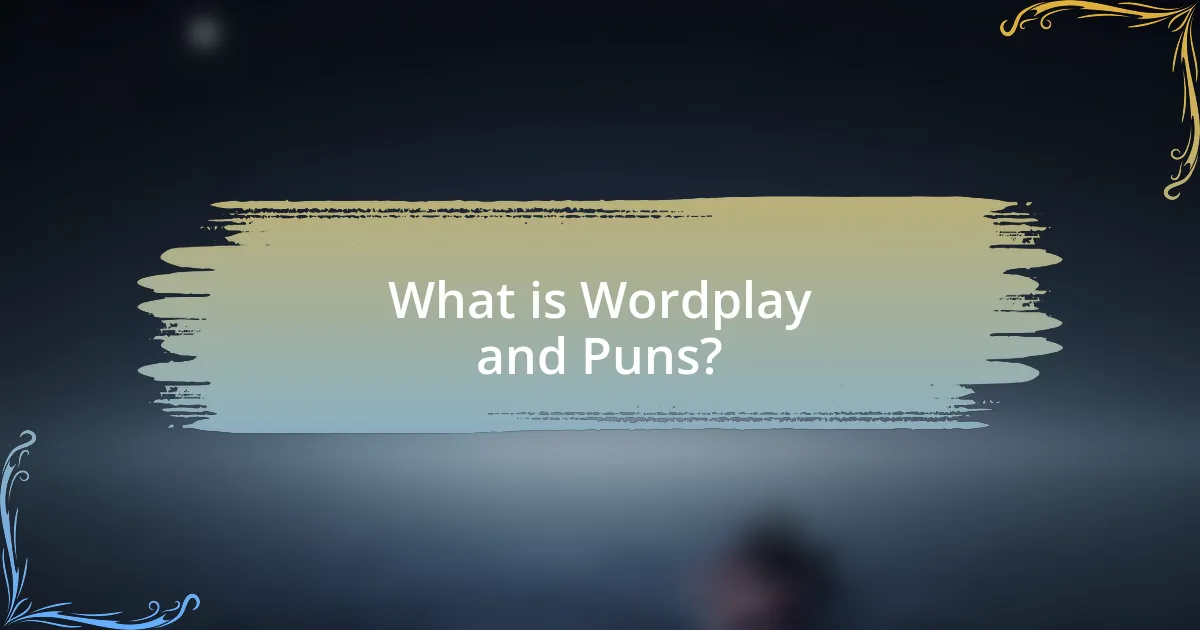
What is Wordplay and Puns?
Wordplay refers to the clever and witty manipulation of language to create humor or a playful effect, while puns are a specific type of wordplay that exploits multiple meanings of a word or similar-sounding words for humorous purposes. Puns often rely on the phonetic similarity between words, such as in the phrase “time flies like an arrow; fruit flies like a banana,” which plays on the dual meanings of “flies.” This linguistic technique has been used throughout history, with examples found in the works of Shakespeare and modern comedians, demonstrating its enduring appeal in humor writing.
How do wordplay and puns contribute to humor writing?
Wordplay and puns significantly enhance humor writing by creating unexpected connections between words, leading to surprise and amusement. This linguistic technique engages readers by playing with the multiple meanings of words or similar-sounding phrases, which can evoke laughter through clever twists. For instance, a pun like “Time flies like an arrow; fruit flies like a banana” utilizes wordplay to create a humorous juxtaposition that surprises the audience. Research indicates that humor derived from wordplay activates the brain’s reward centers, reinforcing the enjoyment of the joke. Thus, the effective use of wordplay and puns not only entertains but also fosters a deeper cognitive engagement with the text.
What are the different types of wordplay used in humor?
Different types of wordplay used in humor include puns, malapropisms, spoonerisms, double entendres, and anagrams. Puns involve exploiting multiple meanings of a word or similar-sounding words for comedic effect, such as in the phrase “Time flies like an arrow; fruit flies like a banana.” Malapropisms occur when a word is mistakenly used in place of a similar-sounding one, often leading to humorous results, as seen in the phrase “He’s the pineapple of politeness.” Spoonerisms involve swapping the initial sounds of words, creating amusing phrases like “Tease my ears” instead of “Ease my tears.” Double entendres are phrases that have two interpretations, one of which is often risqué, such as “I used to be a baker, but I couldn’t make enough dough.” Anagrams rearrange the letters of a word or phrase to create a new one, often with humorous implications, like “Dormitory” becoming “Dirty room.” These forms of wordplay are foundational in humor writing, enhancing creativity and engagement.
How do puns enhance comedic timing and delivery?
Puns enhance comedic timing and delivery by creating unexpected twists in language that surprise the audience, leading to laughter. This surprise element is crucial in comedy, as it disrupts the audience’s expectations and generates a moment of cognitive dissonance, which is often resolved through humor. Research indicates that effective use of puns can increase the perceived cleverness of a joke, making it more memorable and engaging. For instance, a study published in the journal “Psychological Science” found that humor involving wordplay, such as puns, activates areas of the brain associated with language processing and reward, reinforcing the enjoyment of the joke.
Why are wordplay and puns important in writing?
Wordplay and puns are important in writing because they enhance creativity and engage readers through humor. By employing clever language, writers can create memorable phrases that resonate with audiences, making the content more enjoyable and relatable. Research indicates that humor, including puns, can improve retention of information, as seen in a study published in the journal “Psychological Science,” which found that humorous content is more likely to be remembered than non-humorous content. This demonstrates that wordplay and puns not only entertain but also serve as effective tools for communication and information retention.
What role do they play in engaging the audience?
Wordplay and puns play a crucial role in engaging the audience by creating humor that captures attention and fosters connection. These linguistic devices stimulate cognitive engagement, prompting the audience to think critically about the meanings and implications of the words used. Research indicates that humor, particularly through wordplay, enhances retention and recall of information, making the content more memorable. For instance, a study published in the journal “Cognitive Science” by authors such as Jennifer Wiley demonstrates that humor can increase audience involvement and enjoyment, leading to a more effective communication of ideas.
How can they improve the overall quality of humor writing?
To improve the overall quality of humor writing, writers should focus on refining their use of wordplay and puns. Effective humor often relies on clever language manipulation, where the unexpected twist in meaning creates comedic impact. For instance, studies show that humor that incorporates puns can enhance cognitive engagement, as it requires readers to think critically about the dual meanings of words. By practicing various forms of wordplay, such as double entendres and malapropisms, writers can create richer, more layered jokes that resonate with diverse audiences.
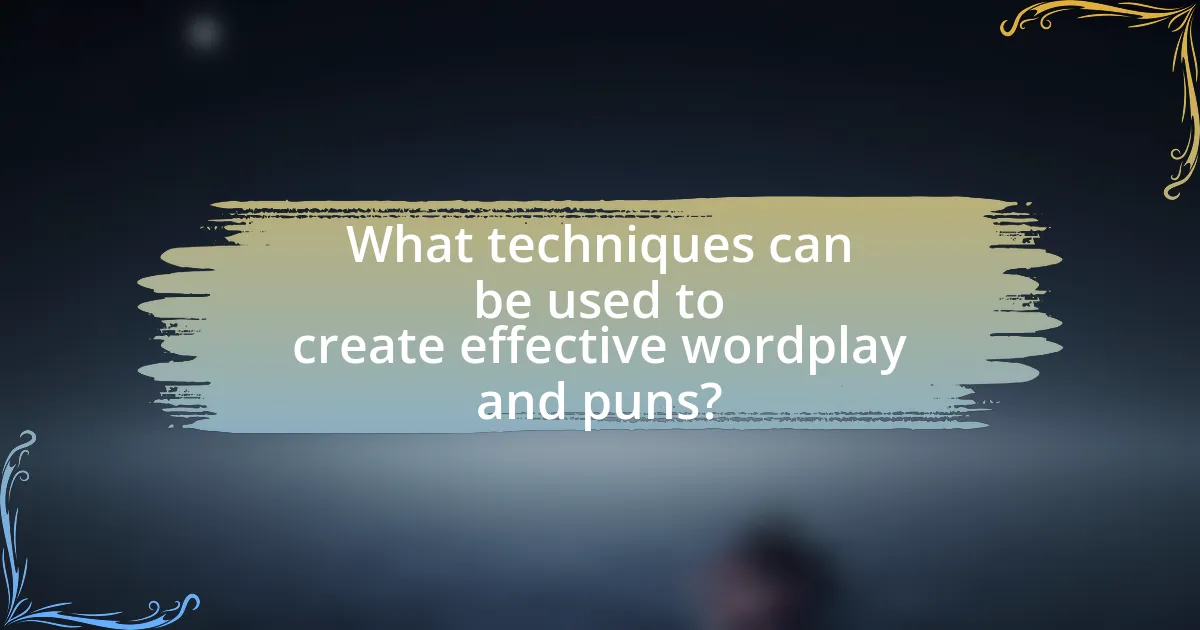
What techniques can be used to create effective wordplay and puns?
Effective wordplay and puns can be created using techniques such as homophony, double meanings, and alliteration. Homophony involves using words that sound alike but have different meanings, allowing for clever twists in language. Double meanings exploit words that have multiple interpretations, creating humor through ambiguity. Alliteration enhances the rhythm and memorability of phrases, making them more engaging. These techniques are supported by linguistic studies that show how phonetic similarities and semantic nuances contribute to humor, as evidenced by research in cognitive linguistics which highlights the role of language play in social interaction and creativity.
How can writers develop their skills in crafting puns?
Writers can develop their skills in crafting puns by practicing wordplay techniques and studying existing examples. Engaging in exercises that focus on homophones, double meanings, and linguistic nuances enhances a writer’s ability to create clever puns. Analyzing successful puns in literature and comedy, such as those by authors like Oscar Wilde or comedians like George Carlin, provides insight into effective pun construction. Additionally, participating in writing workshops or online forums dedicated to humor writing allows for feedback and collaboration, further refining pun-making skills.
What exercises can help improve pun-making abilities?
Engaging in word association games can significantly improve pun-making abilities. These exercises involve quickly generating words related to a given word, which enhances cognitive flexibility and the ability to see connections between different concepts. For instance, playing games like “Word Association” or “Taboo” encourages participants to think creatively and make unexpected connections, which are essential skills for crafting puns. Research indicates that such activities stimulate the brain’s language centers, fostering a more agile thought process conducive to humor and wordplay.
How can writers identify opportunities for wordplay in their writing?
Writers can identify opportunities for wordplay by actively seeking out homophones, puns, and double meanings within their text. This involves analyzing the language used in their writing for words that sound alike or have multiple interpretations, which can create humorous or clever effects. For instance, examining common phrases or idioms can reveal potential for playful reinterpretation, as seen in the phrase “time flies like an arrow,” which can be twisted into “fruit flies like a banana” for comedic effect. Additionally, writers can utilize brainstorming techniques, such as free association or mind mapping, to explore related words and concepts that may lend themselves to playful language.
What are common pitfalls to avoid when using wordplay?
Common pitfalls to avoid when using wordplay include overcomplicating the language, which can confuse the audience, and relying too heavily on puns that may not resonate universally. Overly complex wordplay can alienate readers, as evidenced by studies showing that clarity enhances engagement in humor writing. Additionally, using puns that are too obscure or culturally specific can lead to misunderstandings, as humor often relies on shared knowledge. Therefore, maintaining simplicity and ensuring relatability are crucial for effective wordplay.
How can overuse of puns detract from humor writing?
Overuse of puns can detract from humor writing by overwhelming the audience and diminishing the impact of the jokes. When puns are excessively employed, they can lead to a sense of fatigue, causing readers to disengage rather than enjoy the humor. Research indicates that humor relies on surprise and novelty; thus, repetitive use of puns can make the writing predictable and less effective. For instance, a study published in the journal “Psychological Science” found that humor appreciation decreases when the same type of joke is repeated too frequently, highlighting the importance of variety in comedic writing.
What are some examples of ineffective wordplay?
Ineffective wordplay often includes puns that are overly forced or rely on clichés, making them unoriginal and predictable. For example, using phrases like “time flies like an arrow; fruit flies like a banana” can come off as stale because the humor is based on a well-known structure rather than creativity. Additionally, wordplay that confuses rather than clarifies, such as “I used to be a baker, but I couldn’t make enough dough,” can fail to resonate if the audience does not connect with the metaphor. These examples illustrate how ineffective wordplay can detract from humor writing by lacking freshness and clarity.

How can wordplay and puns be applied in different writing contexts?
Wordplay and puns can be effectively applied in various writing contexts to enhance humor and engage readers. In creative writing, authors use puns to create witty dialogue or amusing character interactions, which can add depth to personalities and situations. For instance, in children’s literature, playful language captures young readers’ attention and aids in language development. In advertising, clever wordplay can make slogans memorable, as seen in campaigns like “Got Milk?” which uses a pun to create a lasting impression. Additionally, in academic writing, puns can serve as a rhetorical device to illustrate complex ideas in a more relatable manner, making the content more accessible. These applications demonstrate that wordplay and puns are versatile tools that can enrich various writing forms by fostering connection and eliciting laughter.
What genres benefit most from the use of wordplay?
Comedy and children’s literature benefit most from the use of wordplay. In comedy, wordplay enhances humor through puns, double entendres, and clever language twists, making jokes more engaging and memorable. For instance, comedians like George Carlin and puns in sitcoms demonstrate how wordplay can elicit laughter and create memorable punchlines. In children’s literature, authors like Dr. Seuss utilize wordplay to stimulate language development and make reading enjoyable, as seen in works like “Green Eggs and Ham,” where playful language captures children’s attention and encourages imagination.
How do puns function differently in poetry versus prose?
Puns function differently in poetry compared to prose primarily due to the structural and rhythmic constraints of poetry. In poetry, puns often enhance the musicality and emotional resonance of the piece, allowing for layered meanings that contribute to the overall aesthetic experience. For instance, poets like Shakespeare frequently employed puns to create double entendres that enrich the text’s thematic depth, as seen in “Romeo and Juliet,” where wordplay adds complexity to character interactions.
In contrast, prose typically prioritizes clarity and narrative flow, using puns more sparingly to inject humor or wit without disrupting the storyline. Prose writers may utilize puns for comedic effect or character development, but the emphasis remains on advancing the plot rather than exploring multiple meanings. This distinction highlights how the medium influences the function and impact of puns, with poetry allowing for greater ambiguity and emotional engagement, while prose focuses on straightforward communication.
What are the cultural considerations when using wordplay in writing?
Cultural considerations when using wordplay in writing include understanding the audience’s linguistic background, cultural references, and humor sensibilities. Different cultures may interpret puns and wordplay differently; for instance, a pun that is humorous in one language may not translate effectively into another due to linguistic nuances or cultural context. Additionally, certain phrases or idioms may carry specific connotations that could be offensive or misunderstood in different cultural settings. Research indicates that humor is often culture-specific, as highlighted in the study “Cultural Differences in Humor: A Review” by Robert A. R. McDonald, which emphasizes the importance of cultural context in humor appreciation. Therefore, writers should be mindful of these factors to ensure their wordplay resonates positively with their intended audience.
How can writers incorporate wordplay into their everyday writing?
Writers can incorporate wordplay into their everyday writing by using puns, double entendres, and clever phrasing to create humor and engage readers. For instance, puns play on the multiple meanings of words or similar-sounding words, allowing writers to add a playful twist to their sentences. Research shows that humor enhances reader engagement, as highlighted in a study by the University of California, which found that humorous content increases retention and enjoyment among readers. By integrating wordplay, writers not only entertain but also make their writing more memorable and impactful.
What are some practical tips for integrating puns into various forms of writing?
To effectively integrate puns into various forms of writing, writers should focus on context, audience, and timing. Context is crucial; puns should relate to the subject matter to enhance understanding and humor. For example, in a cooking article, a pun like “I’m on a seafood diet; I see food and I eat it” can resonate well. Understanding the audience helps tailor puns to their preferences, ensuring they are well-received. Timing is also important; placing puns at strategic points, such as at the end of a paragraph or as a punchline, can maximize their impact. Research shows that humor, including puns, can improve engagement and retention in writing, making it a valuable tool for effective communication.
How can writers balance humor and clarity when using wordplay?
Writers can balance humor and clarity when using wordplay by ensuring that the humor enhances the message rather than obscures it. This can be achieved by selecting puns and wordplay that are relevant to the context and easily understood by the audience. For instance, using familiar phrases or idioms allows readers to grasp the intended humor without confusion. Research indicates that effective humor often relies on shared knowledge and cultural references, which can facilitate understanding while still delivering a comedic effect. By prioritizing clarity in the setup of the wordplay, writers can create a seamless blend of humor and comprehension, making the writing both enjoyable and accessible.
What are the best practices for using wordplay and puns effectively?
The best practices for using wordplay and puns effectively include ensuring clarity, maintaining relevance, and timing the delivery appropriately. Clarity is crucial; wordplay should be easily understood to avoid confusion, as evidenced by studies showing that humor is more effective when the audience can quickly grasp the intended meaning. Relevance enhances engagement; puns should relate to the context or subject matter to resonate with the audience, as demonstrated by successful comedians who often tailor their wordplay to current events or familiar themes. Finally, timing is essential; delivering a pun at the right moment can amplify its impact, supported by research indicating that comedic timing significantly influences audience laughter and enjoyment.
